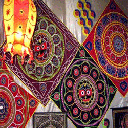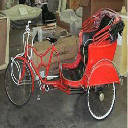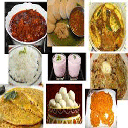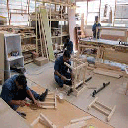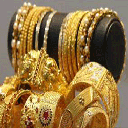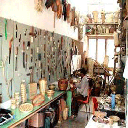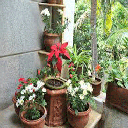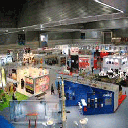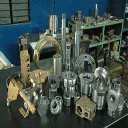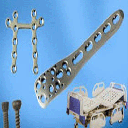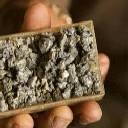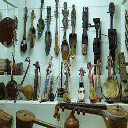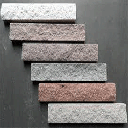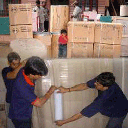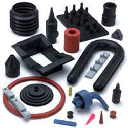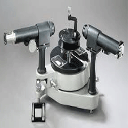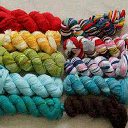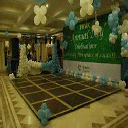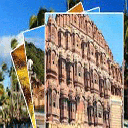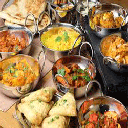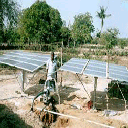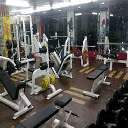Maharashtra is a state located in India. The word Maharashtra is derived from the Sanskrit words Maha meaning Great and Rashtra meaning Nation, thus rendering the name Maharashtra (Great Nation). It is the second most populous after Uttar Pradesh and third largest state by area in India. It is the richest state in India, contributing to 15% of the country's industrial output and 13.2% of its GDP in 2005-06. Maharashtra is bordered by the Arabian Sea to the west, Gujarat and the Union territory of Dadra and Nagar Haveli to the northwest, Madhya Pradesh to the northeast, Chhattisgarh to the east, Karnataka to the south, Andhra Pradesh to the southeast, and Goa to the southwest. The state covers an area of 307,731 km2 (118,816 sq mi) or 9.84% of the total geographical area of India. Mumbai, the capital city of the state, is India's largest city and the financial capital of the nation. Marathi is the language of Maharashtra. Maharashtra encompasses an area of 308,000 km² (119,000 mi²), and is the third largest state in India. It is bordered by the states of Madhya Pradesh to the north, Chhattisgarh to the east, Andhra Pradesh to the southeast, Karnataka to the south, and Goa to the southwest. The state of Gujarat lies to the northwest, with the Union territory of Dadra and Nagar Haveli sandwiched in between. The Arabian Sea makes up Maharashtra's west coast. The Western Ghats better known as Sahyadri, are a hilly range running parallel to the coast, at an average elevation of 1,200 metres (4,000 ft). Kalsubai, a peak in the Sahyadris,near Nashik City is the highest elevated point in Maharashtra. To the west of these hills lie the Konkan coastal plains, 50–80 kilometres in width. To the east of the Ghats lies the flat Deccan Plateau. The Western Ghats form one of the three watersheds of India, from which many South Indian rivers originate, notable among them being Godavari River, and Krishna, which flow eastward into the Bay of Bengal, forming one of the greatest river basins in India. Navegaon National Park, located near Gondia in the eastern region of Vidarbha is home to many species of birds, deer, bears and leopards. Nagzira wildlife sanctuary lies in Tirora Range of Bhandara Forest Division, in Gondia district of Vidarbha region. The sanctuary is enclosed in the arms of the nature and adorned with exquisite landscape. The sanctuary consists of a range of hills with small lakes within its boundary. These lakes not only guarantee a source of water to wildlife throughout the year, but also greatly heighten the beauty of the landscape. Tadoba Andhari Tiger Project, a prominent tiger reserve near Chandrapur in Vidarbha. It is 40 km away from Chandrapur. Pench National Park, in Nagpur district, extends into Madhya Pradesh as well. It has now been upgraded into a Tiger project. Chandoli National Park, located in Sangli district has a vast variety of flora and fauna. The famous Prachitgad Fort and Chandoli dam and scenic water falls can be found around Chandoli National Park. Gugamal National Park, also known as Melghat Tiger Reserve is located in Amravati district. It is 80 km away from Amravati. Sanjay Gandhi National Park, also known as Borivali National Park is located in Mumbai and is the world's largest national park within city limits. Sagareshwar Wildlife Sanctuary, a man made wildlife sanctuary situated 30 km from Sangli. Ancient temples of Lord Shiva and Jain Temple of Parshwanath located in Sagareshwar are a major attraction. Maldhok Sanctuary, situated in Solapur district. Some of its part is in Ahmednagar district. The sanctuary is for a bird which is sometimes known as The Great Indian Bustard. Apart from these, Maharashtra has 35 wildlife sanctuaries spread all over the state, listed here. Phansad Wildlife Sanctuary, and the Koyna Wildlife Sanctuary are the important ones. Apart from the above, Matheran, a Hill station near Mumbai has been declared an eco-sensitive zone (protected area) by the Government of India. Maharashtra has good human resource development infrastructure in terms of educational institutions—301 engineering/diploma colleges, 616 industrial training institutes and more than 24 universitieswith a turnout of 160,000 technocrats every year. It is home to institutions like Centre for Development of Advanced Computing (C-DAC) which developed India's supercomputer, Indian Institute of Technology, Bombay,Sardar Patel College of Engineering, Visvesvaraya National Institute of Technology (VNIT), Veermata Jijabai Technological Institute (VJTI), University Department of Chemical Technology, College of Engineering-Pune (COEP), Government College of Engineering Aurangabad, Government College of Engineering Karad, Walchand College of Engineering-Sangli (WCES), Shri Guru Gobind Singhji Institute of Engineering and Technology Nanded (SGGSIE&T) and top management institutions. 50,000 youth trained to take up self-employment ventures every year by the Maharashtra Centre for Entrepreneurship Development (MCED), Aurangabad. A clock tower amid trees and a playground Rajabai Clock Tower at the University of Mumbai IIT Bombay Main Building The literacy rate is well above the national average at 77.27%.University of Mumbai, one of the largest universities in the world in terms of the number of graduates. The Indian Institute of Technology (Bombay),Veermata Jijabai Technological Institute (VJTI), and University Institute of Chemical Technology (UICT), which are India's premier engineering and technology schools, and SNDT Women's University are the other autonomous universities in Mumbai. Mumbai is home to Narsee Monjee Institute of Management Studies (NMIMS), National Institute of Industrial Engineering (NITIE), Jamnalal Bajaj Institute of Management Studies (JBIMS), S P Jain Institute of Management and Research, K J Somaiya Institute of Management Studies and Research (SIMSR) and several other management schools.Government Law College and Sydenham College, respectively the oldest law and commerce colleges in India, are based in Mumbai. The Sir J. J. School of Art is Mumbai's oldest art institution.College of Engineering-Pune, established in 1854 is the third oldest college in Asia. Mumbai is home to two prominent research institutions: the Tata Institute of Fundamental Research (TIFR) and the Bhabha Atomic Research Centre (BARC). The BARC operates CIRUS, a 40 MW nuclear research reactor at their facility in Trombay. The University of Pune, the National Defence Academy, Film and Television Institute of India, National Film Archives, Armed Forces Medical College and National Chemical Laboratory were established in Pune after the independence of India. ILS Law College, established by the Indian Law Society is one of the top ten law schools in India. Established medical schools such as the Armed Forces Medical College and Byramjee Jeejeebhoy Medical College train students from all over Maharashtra and India and are amongst the top medical colleges in India. Military Nursing College (affiliated to the AFMC) ranks among the top nursing colleges in the world. University of Nagpur, established in 1923, one of the oldest universities in India, manages more than 24 engineering colleges, 43 science colleges and many colleges in the Arts and Commerce faculties. Nagpur is the home for Visvesvaraya National Institute of Technology (VNIT) (also referred to as NIT, Nagpur, formerly known as Visvesvaraya Regional College of Engineering (VRCE), Nagpur) is one of the first six Regional Engineering Colleges established under the scheme sponsored by Government of India and the Maharashtra State Government and is one of the Institutes of National Importance. Thus the universities in Maharashtra include (alphabatical): Amaravati University (Amravati), Bharati Vidyapeeth (Pune), Central Institute of Fisheries Education (Mumbai), Deccan College Post Graduate & Research Institute (Pune), Dr.B R Ambedkar Marthwada University (Aurangabad), Dr Babasaheb Ambedkar Technology University (Lonere), Dr Panjabrao Deshmukh Krishi Vidyapeeth (Akola), Gokhale Institute Of Politics & Economics (Pune), Indian Institute of Technological Mumbai (Mumbai), Indira Gandhi Institute of Develop. Research (Mumbai), International Institute for Population Sciences (Mumbai), Konkan Krishi Vidyapeeth (Dapoli), Mahatma Phule Krishi Vidyapeeth (Rahuri), Marathwada Krishi Vidyapeeth (Parbhani), Nagpur University (Nagpur), North Maharashtra University (Jalgaon), Shivaji University (Kohlapur), Smt. Nathivai Damodar Tackersey Women's University (Mumbai), Solapur University (Solapur), Swamy Ramanand Teerth Marathwada University (Nanded), Tata Institute of Social Sciences (Mumbai), Tilak Maharashtra Vidyapeeth (Pune), University of Mumbai (Mumbai), University of Pune (Pune), Yashwantrao Chavan Maharashtra Open University (Nashik). The geographical center of India lies at Nagpur, known as Zero Mile Stone. Nagpur is the headquarter for Hindu nationalist organisation Rashtriya Swayamsevak Sangh (RSS) and an important location for the Dalit Buddhist movement. Nagpur is also the home for National Fire Institution, Rashtrabhasha Prachar Samiti (promotion of and for spreading the national language, Hindi) and National Thermal Power Corporation (NTPC-Western zone). Maharashtra in total, has 40% India's Internet users and 35% of PC penetration in the country.
Aga Khan Palace:Agakhan Palace, Agakhan Palace historical, Agakhan Palace travel, Agakhan Palace tourism, Agakhan Palace Historical PlaceOn Nagar Road, this Palace is also recognized as Kasturba Gandhi Memorial or Kasturba Samadhi. This palace was built in 1892 by Imam Sultan Muhammad Shah Agakhan III and was donated to India in 1969 by Aga Khan IV. It was here itself where Kasturba Gandhi and Mahatma Gandhi's long time aide Mahadeobhai Desai passed away. This palace that once belonged to the Agha Khan, served as quarters for imprisonment of Gandhi and his wife Kasturba towards the tail end of the British rule in India. Situated near the River Mula the palace is a simple memorial to Gandhi and his life and times. A special cenotaph honours Kasturba who died here. A shop attached sells khadi or cotton handloomed garments and textiles. Also called the Gandhi National Memorial or the Yerewada Ashram it is located at Talegaon Road, beyond Fitzgerald Bridge. Ajanta Ellora Caves:Ajanta-Ellora caves, Ajanta-Ellora caves historical, Ajanta-Ellora caves travel, Ajanta-Ellora caves tourismThe Ajanta caves are 108 kms north-east of Aurangabad .The caves are carved in the rock face which is in the face which is in the form of a horse-shoe through which flows the stream Waghora.Situated in this beautiful surroundings are 30 Buddhist caves some unfinished comprising of either viharas (monastic halls) or chaityas(chapels)containing important examples of Buddhist architecture.Despite its age ,most of the frescoes and sculptures are remarkably well preserved .Natural light illuminates the caves at certain times of the daywhich leave you awestruck by the sheer brilliance of its architectural splendour.The Ajanta caves is placed in the World Heritage List of Monuments & a true "Wonder of the World".The Ellora caves are 29 kms Noth-West of Aurangabad.This rock-cut caves were constructed between sixth to the tenth century A.D & are included in the World Heritage.There are about 34 caves-12 Buddhist,17 Hindu,5 of Jain faith. History A wonderful example of cave temple architecture, the world heritage Ellora caves own elaborate facades and intricately carved interiors. These carved structures on the inner walls of the caves reflect the three faiths of Hinduism, Buddhism and Jainism. These exotic caves were carved during 350 AD to 700 AD period. The Chalukya - Rashtrakuta rulers (7th - 10th cnetury) were the main patrons of the cave temples of Ellora. Many kings and Merchants donated huge sums of money for the construction of these cave temples. Some religious beliefs and ethical codes forced the rulers to encourage the buliding of these temples. Building of these temples was supposed to give salvation and religious excellance to the kings. The enchanting cave shrines of Ellora are an added value to the great Indian Heritage. The Caves Ajanta-Ellora caves, Ajanta-Ellora caves historical, Ajanta-Ellora caves travel, Ajanta-Ellora caves tourismThe incredible caves of Ajanta are dedicated exclusively to Buddhism. There are around 30 caves here and are divided into 'Chaitya-Grihas' (stupa halls) and 'Viharas' (dwelling halls). Around five of these caves (9, 10, 19, 26 and 29) are 'Chaitya-Grihas'. The rest of the caves are 'Sangharamas' or Viharas (monasteries). The caves 1, 2, 16 and 17 are important from the art point of view. They are great pieces of art compared to the contemporary art world. These caves have exotic paintings illustrating the life and incarnations of Buddha. The carvings and the paintings of the Ajanta caves tell us about the imagination and creativity of the artist. The murals on the walls of these caves are still in a good condition, maintaining the freshness of the color and spreading vibrancy in the atmosphere. Visitors will definitely enjoy watching these great historical pieces of art. The Viharas The Ajanta caves were divided into several viharas (dwelling halls) and chaitya-grihas (stupa halls), scooped out of the sloping rocks in the fifth century CE. The viharas consisted of a broad verandah. The roof of this verandah was supported by pillars and giving towards the interior on to a hall averaging in size about 35 ft. by 20 ft. Also there are dormitories to the left, right and back , opening on to this hall. The number of dormitories varied according to the size of the hall, and in the larger ones pillars supported the roof on all three sides, forming a sort of religious residence running round the hall. There is also a shrine of lord Buddha in a niche facing the entrance and sometimes facing the subsidiary shrines to the right or left of the entrance. With the help of carvings, the facades of the viharas were decorated and the paintings adorned the walls and ceilings. Ajanta-Ellora caves, Ajanta-Ellora caves historical, Ajanta-Ellora caves travel, Ajanta-Ellora caves tourismThe Chaityas The chaitya-grihas are greater than the viharas. The largest chaitya-grihas being 94 1/2 ft. from the verandah to the back and 41 1/4 ft. across, including the cloister. Earlier, the chaitya-grihas at Ajanta had stupas, but later they had a standing or seated image of the Buddha in front of them. One of the signs of changing patterns of worship is the bodhisattva cult that was practiced at Ajanta. The Bodhisattvas are heavenly beings on the brink to Buddhahood. It is said that they chose to remain in the world to help others towards salvation. The figures off these bodhisattvas are carved at the entrance of a vihara or chaitya-griha or are painted on walls. Paintings Ajanta-Ellora caves, Ajanta-Ellora caves historical, Ajanta-Ellora caves travel, Ajanta-Ellora caves tourismThe famous wall paintings in Ellora are found in 5 caves, but these paintings are preserved only in Kailasa temple. These paintings were painted in two series, first, at the time of carving the caves and second, after many centuries later. The paintings of the first series show Lord Vishnu and Goddess Lakshmi. In the later series the main composition is that of a procession of Shaiva holy men. The paintings also show gracefully flying 'Apsaras'. Sadly, very few such murals in the Jain temples are well preserved. Festival The MTDC organizes the famous Ellora Festival of classical dance and music at these caves every year in the third week of March. Conclusion The Ajanta caves and the treasures they house are a landmark in the overall development of Buddhism as such. It provides a unique opportunity to study the early phases of Buddhist sculpture, painting and architecture, which later influenced artistic traditions in central Asia and Far East. Bibi Ka Maqbara:Bibi Ka Maqbara is the tomb of Begum Rabia Durani,wife of Emperor Aurangazeb. The monument is an excellent example of Persian Architecture. The arched aclove surmounted by a swelling dome, the idea had acquired its own reputation in India. Bibi Ka Maqbara is considered to be a poor imitation of Taj Mahal in Agra. The layout and surrounding of the tomb is very much similar to that of Taj but some how the architecture fails to produce the magic of Taj. Nevertheless, the monument has its own charm and has been attracting tourist far & wide. The Construction Bibi Ka Maqbara, Bibi Ka Maqbara historical, Bibi Ka Maqbara travel, Bibi Ka Maqbara tourism, Bibi Ka Maqbara Historical The Bibi-Ka-Maqbara is made mostly of sandstone and has plastered walls (a cost cutting measure), and a marble dome. The expert - Ustad Ata-ullah came from Persia. Bibi Ka Maqbara is known as the South Indian Taj. However, if the delicacy of work is compared, it falls far short of the glory of the Taj at Agra. Below the tomb, lattice works are in marble. However, the lattice work and inlay decorations of flowers and creepers are beautiful. The Masjid is to the west. A high wall with bastions runs around edifice and the recesses have little minarets. The entrance leads to an arch and from this point, a fine view of the structure ahead may be obtained. The pavement that leads to mausoleum is flanked by oblong reservoirs. Added Attraction There is a new newest attraction - every October, MTDC celebrates the Bibi Ka Maqbara annual festival. General View The interior decoration has nothing comparable with the great architectural wonder at Agra. Yet a comparison apart, Bibi-ka-Maqbara has its own splendour and grace. It is considered as a fine piece of Moghul architecture in the Deccan region. Elephanta Caves:Elephanta Caves, Elephanta Caves historical, Elephanta Caves travel, Elephanta Caves tourism, Elephanta Caves HistoricalOne of the major attractions of Maharashtra, the Elephanta Caves is located near the metropolitan city of Mumbai. The Elephanta Island is located 10 km away from the Gateway of India. There are various rock cut temples present in these caves, which are as old as 5th century. The Elephanta Island was named by the Portuguese, after the statue of an elephant near the landing area of the island. Construction of the Caves The rock cut temples in Elephanta caves are carved out of rock. There are columns, internal spaces and images within these temples. The whole temple is associated to a big statue. In fact one can walk through the corridors and chambers of this sculptured temple. Created through a process of rock removal, the entire complex is an interesting monument. Some of the rock surfaces here are finely finished whereas some are unfinished bare rock. There are three entrances to the temple. The eastern and the western entrances mark the axis of the temple. There is a 20 pillared hall that lines the axis, and on its western end is a cell in which a Shivalingam enshrined. The Mystical Images Elephanta Caves, Elephanta Caves historical, Elephanta Caves travel, Elephanta Caves tourism, Elephanta Caves HistoricalThe magnificent image of Sadasiva, a manifestation of Shiva, is carved in relief at the end of the north south axis. The stupendous 20 feet high image of the three headed Shiva, known as Trimurthy is a magnificent one. It is regarded as a masterpiece of Indian art. This huge image represents Panchamukha Shiva, whose only three faces are carved into the wall. It attracts your attention just as you enter the temple through the northern entrance. Along with this image there are grand sculptured images of Kalyanasundara, Gangadhara, Ardhanariswara and Uma Maheswara on the southern wall. Other sculptured images of Nataraja and andhakaasuravadamoorthy are to the west of the northern entrance and the images of Yogiswara and Ravanaanugrahamurthy are to its east. Reach Elephanta Caves The Elephanta Island can be reached only by boat. Ferry rides are available from the Gateway of India and it takes just 15 minutes to reach the Elephanta Island. It is one of the most adventurous ride as the boat cruise up and down the wavy sea making it a life time experience. Haji Ali Mosque:Haji Ali Mosque, Haji Ali Mosque historical, Haji Ali Mosque travel, Haji Ali Mosque tourism, Haji Ali Mosque HistoricalThis mosque is located in the causeway protruding into the Arabian Sea. The white mosque is the tomb of Saint Haji Ali. Haji Ali was a rich Muslim who renounced the world and proceeded to Mecca. It is said that he died in Mecca and the casket miraculously drifted and came to the spot where the mosque is built toady. Jehangir Nicholson Museum of Modern Art (Mumbai):Jehangir Nicholson Museum of Modern Art, Jehangir Nicholson Museum of Modern Art historical, Jehangir Nicholson Museum of Modern Art travel, Jehangir Nicholson Museum of Modern Art tourism, Jehangir Nicholson Museum of Modern Art Historical Place, travel to Jehangir Nicholson Museum of Modern Art MonumentJehangir Art Gallery is situated at Kala Ghoda locality of Mumbai, Maharashtra. Constructed in 1952, this art gallery is the most prestigious and modern place for Indian artistes in the city. There are four demonstration halls to exhibit the work of art here. There is massive rush of artistes in this gallery to show one's works. Many of the artistes have to pass the time a couple of years to exhibit their works in this gallery. The gallery has a huge media notice and coverage. Donated by Cawasji Jehangir, Jehangir Art Galleryis it is managed by the Bombay Art Society. The building of the gallery is an vast gorgeous mansion. Jehangir Art Gallery is one of the Mumbai's well-known art galleries. Khuldabad:Khuldabad, Khuldabad historical, Khuldabad travel, Khuldabad tourism, Khuldabad Historical Place, travel to Khuldabad22 Kms. From Aurangabad. Khuldabad is called the "Valley of the Saints" because of a large-scale Sufi migration to this spot a number of hundred years ago. It is a sacred shrine for the Muslims and contains the tomb of the last Mughal emperor, Aurangzeb. The Urs celebrated here for five days is a very well-known fair and gathers a large number of Muslims. Mastani Mahal:Mastani Mahal, Mastani Mahal historical, Mastani Mahal travel, Mastani Mahal tourism, Mastani Mahal Historical PlaceLegends about Mastani and her presumed stay at Shaniwar Wada apart, it is most certain that Bajirao I did build for her a palace at Kothrud. Laying waste in the wilderness, the Mahal was recreated by Pune's 'Kaka' Dinkar Kelkar. An avid art collector, 'Kaka' transplanted the fine wooden pillars and wall paintings to his museum at Pune. The living room of the Wada as assembled in the same style from the original woodwork here reveals the intricate architecture and woodcarving as well as wall paintings. The superb furnishings evoke the atmosphere of the home of Mastani,whose portrait on glass is also present in the museum National Maritime Museum (Mumbai):National Maritime Museum, National Maritime Museum historical, National Maritime Museum travel, National Maritime Museum tourism, National Maritime Museum Historical Place, travel to National Maritime Museum MonumentNational Maritime Museum is situated in Mumbai, Maharashtra. The museum conserve the historical assets of India obtained from other countries and models of ships built in Mumbai. The Indian Navy set up the museum for this purpose. Mumbai port is one of the busiest ports of India, handling approximately 40% of India's maritime trade. British developed this natural harbor port. Mumbai is well associated by air, rail and road with any part of India. Prince of Wales Museum of Western India:Prince of Wales Museum of Western India, Prince of Wales Museum of Western India travel, Prince of Wales Museum Prince of Wales Museum King George V, who as Prince of Wales, laid the foundation stone of this museum in 1905. Situated near the gateway of India, it was designed in the indo-Saracenic style to commemorate the King's first visit to India. During the First World War, it was used as a hospital. It was opened as a museum in 1923 and has three main sections: Art, Archaeology and Natural History. One of the best museums in the country, it is a treasure house of art, sculpture, China, rare coins and old firearms. It also has a priceless collection of miniature paintings. The major endeavour of the Art section at the museum was to develop its collection of Indian paintings so that it represents the different styles and phases. Consequently the collection presents the evolution of painting in India, ranging between 11th and 12th century illustrated palm leaf manuscripts to early 19th century Pahari paintings. Exquisite examples of all the main schools of miniature painting are on view, Rajput, Mughal, Pahari, and Deccani Each school with its characteristic style has its own delicacy of form and colour. The glistering white marble dome crowning this building can be sighted from a distance as it lies nestled amidst a well-laid out garden. Shahaji Chhatrapati Museum (Kolhapur):Shahaji Chhatrapati Museum, Shahaji Chhatrapati Museum travel, Shahaji Chhatrapati Museum tourism, Shahaji Chhatrapati Shahaji Chhatrapati Museum is at fresh Palace in Kolhapur, Maharashtra. Curious and interesting set from the possessions of Maharaja Shahaji Chhatrapati like guns, trophies and clothes are potted here. The Maharaja was died freshly died in 1983. British architect Charles Mant designed the New Palace in 1881 in the Indo-Sarcenic style. The museum also has large, brilliant weapons collection, including a gold-plated, double-barreled shotgun, some swords, and other guns. There is also one of Aurangzeb's swords at the Shahaji Chhatrapati Museum. Kolhapur is well associated by air, rail and road with major cities of India. Hotels are existing in Kolhapur Taraporewala Aquarium (Mumbai):Taraporewala Aquarium, Taraporewala Aquarium travel, Taraporewala Aquarium tourism, Taraporewala Aquarium Historical PlaceTaraporewala Aquarium is at crowded locality of Marine Drive in Mumbai, Maharashtra. It has nautical life and rare kind of fishes and beautiful pearl jewellery. The aquarium has plans to renovate shortly into a high-tech Aquarium with special attractions like glass vision sea-world and an underwater sea walk. The first President of free India, Dr. Rajendra Prasad officially opened it in 1951. The Aquarium has sea life like shark, octopus, kite fish, corals, worms, sea flower, sea horses, pearls and shells. Articles crafted from shells and pearls are also displayed here. Mumbai is well linked by air, rail and road with major cities of India. Victoria Terminus:Victoria Terminus, Victoria Terminus travel, Victoria Terminus tourism, Victoria Terminus Historical Place, travelA major landmark of Mumbai city is the Victoria Terminus, designed in Italian Gothic style by Architect F. W. Stevens. Recently renamed as Chatrapati Shivaji Terminus, it is one of Mumbai's most prominent buildings and architecturally one of the finest stations in the world. The building construction commenced in 1878 and was completed in 1885. With a frontage of over 1500 feet, The administrative offices form three sides of a rectangle enclosing an ornamental garden and the entrance gate is guarded by a massive stone Lion and Tiger. The most prominent feature of this building is the high 160 feet dome crowning the centre. On top of the giant dome is a statue of a women with a torch held aloft to symbolize progress. At the top of the central dome stands the triumphant figure of Progress. The station was christened to commemorate Victoria Jubilee Day in 1887 when India's first steam engine puffed out to neighboring Thane, about 45 kms away. Today it has been rechristened Chhatrapati Shivaji Terminus after the Maratha warrior. And the old steam engines have been replaced by electric ones. But to the 2.5 million commuters who push past its massive portals everyday, this is still VT, the pulse of a throbbing city. Vijaydurg & Sindhudurg Fort:Vijaydurg & Sindhudurg Fort, Vijaydurg & Sindhudurg Fort travel, Vijaydurg & Sindhudurg Fort tourismOnce naval bases, Vijaydurg and Sindhudurg bear testimony to Maharashtra's martial supremacy during Shivaji's reign. Vijaydurg or Victory Fort was strengthened around the seventeenth century by Shivaji, to whom it owes its finest features -- the triple line of walls, the numerous towers and the massive interior buildings. Once seized by the British and renamed Fort Augustus, Sindhudurg or the Ocean Fort at Malvan port has history etched all over. Constructed by Shivaji in 1664, at a site personally selected by him. The construction of a sea fort is a stupendous task, and at Sindhudurg no efforts were spared. Over 2000 khandis (4000 mounds) of iron were used for casting and the foundation stones were laid down firmly in lead. Tourism of Central India can also customize your tour to the Forts in Maharashtra, to include other stunning forts in Maharashtra namely Daulatabad, Gavilgad, Ghodbunder, Murud-Harnai and Sinhagad. We can also club your tour with beaches in Maharashtra tours so that you can have an enriching and entertaining vacation in Maharashtra. Even today, as one approaches the fort past a rocky reef, navigable through a narrow channel, one marvels at the transportation of such heavy material through such choppy waters. Within its precincts are temples holding the shrines of Maruti, Bhavani, Mahadeo, Jarimai, Mahapurush and also of Shivaji -- the only such shrine in the country. As for Vijaydurg and Sindhudurg beaches, they offer the visitor one of the most serene and beautiful coastal views in India. Bassein Fort in Maharashtra:Bassein Fort, Bassein Fort historical, Bassein Fort travel, Bassein Fort tourism, Bassein Fort Historical PlaceA Portuguese stronghold till 1739 when the Marathas took over, Bassein Fort is a place you should not miss on your tour of forts in Maharashtra. Standing guard over the Arabian Sea, for centuries it has overlooked the Bassein Beach that thrives as a popular tourist destination and was once an important shipbuilding site. You can also visit the temples (Vajreshwari Temple) and churches that have survived the beatings of time. Also of historical significance is the capital of Konkan, now a small village near Bassein called Nalasopora. Bassein's wide beaches lined with palm groves, Akoli Hot Springs, and fort ruins resemble the Goan coastline to a large extent and are the ideal place to relax. Bombay Natural History Society:Bombay Natural History Society, Bombay Natural History Society historical, Bombay Natural History Society travelThis private institution was established in 1883, A unique centre, its behavior are manifold and involve publications like the Journal of Bombay Natural History Society, usual newsletters and books on Indian animals, birds and nature. The exhibits include replicas and specimens of vertebrates and insects, mammals, birds, reptiles amphibians and fishes, all from the Indian subcontinent. However, the BNHS is not open to public and interested visitors should seek prior permission for admission. Flora Fountain:Flora Fountain, Flora Fountain historical, Flora Fountain travel, Flora Fountain tourism, Flora Fountain Historical PlaceFlora fountain stands at a busy five-point intersection in the heart of the comercial fort area. The beautifully sculptured fountain was erected in the memory of the Governer, Sir Henery Bartle Edward Frere, as a tribute for his contribution towards the building of Mumbai. This fountain, located in the heart of the city, was built in 1869 in honour of Sir Bartle Frere, who was governor of Mumbai from 1862-67. Flora Fountain marks a junction of five streets and is referred as the 'Piccadilly Circus' of Mumbai. Decorated with mythological figures, the fountain is a stone structure with a sculpture of the Roman Goddess of abundance, at the top. Many of the major banks and offices are located in Flora Fountain. Close to the fountain is the Cathedral of St. Thomas. The construction of the chapel began in 1672 and completed in 1718. Heras Institute of Indian History & Culture:Heras Institute of Indian History, Heras Institute of Indian History historical, Heras Institute of Indian History travelDisplayed at the Heras Institute arc group of Mesopotamian antiquities like cylindrical seals and terracotta objects. The Indian antiquities include prehisto'ric pottery, sculpture from Gandhara, Mathura and the Gupta schools. There are Hindu, Jain and Buddhist icons. However the most remarkable section is on Christian ivories from Gba. On view are images of saints, the Virgin Mary and Jesus Christ. Karla Caves:Karla, Bhaja & Bedsa Caves, Karla, Bhaja & Bedsa Caves historical, Karla, Bhaja & Bedsa Caves travel, Karla, Bhaja Karla Caves about 10 kms from Lonavla is the site of the biggest Chaitya cave in India dating back to 80 B.C.Carved inside are a numeral of inscriptional records in Brahmi characters giving the names of donors who contributed for the excavation of this cave. At the entrance of the caves is a pillar with three lions on it & on the other side the temple of Goddess Ekveera. Bhaja Caves:Nearby are the Bhaja caves which are as old as the Karla caves .Sculptures & ornamental designs in the caves are worth seeing. Bedsa Caves:The first century A.D cave has beautiful carvings & story telling inscriptions Lal Mahal:Lal Mahal, Lal Mahal historical, Lal Mahal travel, Lal Mahal tourism, Lal Mahal Historical Place, travel to Lal Mahal In its present renovated avatar, a formation of the Pune Municipal Corporation in 1983, the Lal Mahal resembles more a sandstone- red palace, than a traditional Wada. Historians assume it to have been built by Dadaji Konddev in 1640, two years after he had ownership of the city from the Adilshahi Sultans.Konddev brought Shivaji up here, and hence the modern structure built accords pride of place to a marble bust of Jijabai. It was also in this configuration that the Mughal general Shaista Khan sent by his king and nephew Aurangazeb to end Shivaji's political power lost three fingers while trying to escape through the window on being taken by surprise by a small band of Maratha soldiers in the dark of the night. Murud Janjira Fort in Maharashtra:Murud Janjira Fort, Murud Janjira Fort historical, Murud Janjira Fort travel, Murud Janjira Fort tourism, Murud JanjiraThe island fort of Murud Janjira is a well-known architectural heritage from a lesser-known dynasty that has stood unconquered for centuries. A symbol of the Siddi dynasty from Janjira that stood strong against the British and Maratha Empires, there are number of tourists attractions present at Murud Janjira. From the beaches at Nandgaon (Ganapati Temple) and Kashid to the Palace of the Nawabs and Janjira caves, you can see them all on your tour to Murud Janjira Fort in Maharashtra. Nehru Science Center:Nehru Science Center, Nehru Science Center historical, Nehru Science Center travel, Nehru Science Center tourism, NehruNehru Science Centre exhibits actively involve the visitor in discovering information through participation in the demonstration process. A huge sprawling four storeyed building houses the nine galleries. The hexagonal gallery, Science for Children, has an assortment of exhibits where children play with soap bubbles, primary colours, geometrical shapes and forms, tricky, puzzles, all of which make science learning a tun thing. Sound and Hearing and Light and Sight are specialized galleries and clarify how sound is formed and heard, what resonance is, interference, echo, musical notes, the properties of Ught and colour, use of lenses, complexity of the human eye. A small gallery deals with life sciences and the evolution of man. Here a transparent woman, a mannequin, explains to visitors about the human anatomy. Discovery and computers are highly popular. The science park gives visitors a chance to experiment with exhibits, press levers, turn wheels, roll balls, pull strings and look through periscopes and telescopes. S.ciimce at the Centre is not a dry, theoretical subject. Instead, through inspection, involvement and other related behavior scientific awareness and formulae is inculcated in children. Raigad Fort:Raigad Fort, Raigad Fort travel, Raigad Fort tourism, Raigad Fort Historical Place, travel to Raigad Fort MonumentThis is the very heart of Maratha country -- Raigad, the capital of Shivaji's kingdom. Strategically perched atop a wedge-shaped block of hill, split off from the Western Ghats and inaccessible from three sides. Stories of incredible valour and heroic deeds are etched on every pebble at Raigad. It was here that Shivaji built his capital city in the 14th century, and here that he crowned himself Chhatrapati. For six years up to his death, Raigad remained the capital of the Marathas with its broad gates and magnificent monuments. There was only one pathway leading to the top, and prizes were offered to those who scaled the fort through unconventional methods. Though parts of Raigad are in ruins, yet they inspire an aura of grandeur. Shivaji's impregnable capital, the place where he was crowed and where he died. Besides the fort, you'll find his samadhi and the remains of his palace. For its immence beauty, Raigad remains a hiker's paradice.The formidable Pratapgad fort with its equestrian statue of shivaji is an interesting excursion. You can also visit Gangasagar Lake or worship at the nearby Jagadishwar Temple or pay your respects to the great Maratha warrior at his Samadhi. For Trekking Raigad Fort, Raigad Fort travel, Raigad Fort tourism, Raigad Fort Historical Place, travel to Raigad Fort MonumentThere are many interesting routes to Raigad, varying from the relatively easy to the challenging. The path starts from Pachad, 24 kms from Mahad, a shallow sea port on the banks of the Savitri River. Raigad can also be an adventure-filled day excursion from the hill station of Mahabaleshwar or from Pune. Places to see near by Raja Dinkar Kelkar Museum is in Pune, Maharashtra. The museum has nearly around 20,000 collections of objects paintings, handicrafts, armour-suits, musical instruments and many other objects of art and artifacts collected from all over the world. The building has been designed in a Rajasthani-style, but the galleries give a clear depiction of the life and culture of the Marathas. Dinkar Kelkar spent almost 60 years traveling and purchasing objects from the remote areas and towns of India. Dividing into 36 sections, the collections are confined mostly to everyday life like pots, lamps, containers, nutcrackers, pen stands. 'Mastani Mahal' is regarded to be the masterpiece to this museum, which was erected here in its original form. The wood carvings include carved wooden doors and windows from Rajasthan, Gujarat, Karnataka and Kerala. The metal objects include locks, ink pots, ritual bowls and nutcrackers. There are also an assortment of oil lamns in and copper. Another collection is of the paintings from addition is the section on women, which depicts their important role in Indian society. Articles belonging to Mughal and Maratha periods that date back to 17th century are displayed at Raja Dinkar Kelkar Museum. Musical instruments, metalwork, exquisite chitrakathi Paintings and a unique lock collection are the other attractions of the museum. Shri Bhavani Museum ( Aundh ):Shri Bhavani Museum, Shri Bhavani Museum travel, Shri Bhavani Museum tourism, Shri Bhavani Museum Historical Place, travel to Shri Bhavani Museum MonumentShri Bhavani Museum in Aundh, which is 48 km from Satara in Maharashtra. The museum has 500 miniature paintings of all major schools - Jaipur, Kangra, Mughal, Punjab, Bijapur, Pahadi and Maratha of the period between 15th and 19th century. The Museum exhibits mainly the work of Bhawanrao done in his lifetime. Shri Bhavani Museum also has the famous stone shaped structure of 'Mother and Child' by Henry Moore. It was final exhibited in Delhi 10 years ago. Shri Bhavani Museum has a large division devoted to stone created structures including the famous 'Mother and Child' by Henry Moore. The museum has four sections completely devoted to Western paintings that include Madonna of the Book by Andrea Del Sarto; a Rembrandt self-portrait, In The Prison Of Aurangzeb by A.H. Muller, Beggar Boy by Bartona Morilla, Franciso by L. Goya, Boy Volunteer by G.G. Hierice, Game of Draughts by F. Morelli, Pairs by Cornil and many more. Tilak Smarak Mandir:Tilak Smarak Mandir, Tilak Smarak Mandir travel, Tilak Smarak Mandir tourism, Tilak Smarak Mandir Historical PlaceTilak Smarak Mandir on Tilak Road is a building commemorating the immense freedom fighter and communal reformer Lokmanya Tilak. There is a little museum on the ground floor telling Tilak's public life and a theatre on the upper floor. Victoria & Albert Museum:Victoria & Albert Museum, Victoria & Albert Museum travel, Victoria & Albert Museum tourism, Victoria & Albert MuseumAdjoining the Victoria Gardens, this museum built in the Greco-Roman style houses archaeological finds, maps and photographs depicting the history of Mumbai. Veermata Jeejamata Museum, also known as Victoria and Albert Museum is in Mumbai, Maharashtra. This museum is also known as Bhau Daji Lad Museum, as Bhau Daji Lad put all his efforts to establish this museum. Rock cut elephants, which was brought by British in 1865 from Elephanta Island, is preserved here. The surrounding is Botanic Gardens spreading on an area of 48 acres. Clay models equivalent of firka paintings made for the British in the 'Company' period-'illustrating' Indian types, and costumes, and trades and professions; finely wrought silver and copper ware; votive bronzes to fossils and minerals, delicate ivories to models of temples made from pith are some of the fine collections of this museum. Photographs of old Bombay and European bric-a-brac; wonderful Armour and garishly colored 'fruit' models are also displayed in the museum. Vishrambaug:Vishram Baug, Vishram Baug travel, Vishram Baug tourism, Vishram Baug Historical Place, travel to Vishram Baug MonumentA three-storied mansion remarkable for its good-looking entrance and the balcony with carved woodwork classic of the Peshwa period. Noted historian Babasaheb Purandare has undertaken the task of transforming the central courts and the hall into their original grandeur adding hugely to the beauty of the place. A one storeyed Wada, Vishrambaug curiously was once a garden, and is said to have resulting its name from its gardener called Vishram. The 260ft. Long and 815ft. broad Teen - Chowki Wada wad built by the last Peshwa Bajirao II as his residence. Bharata Itihasa Samshodhak Mandal:Bharata Itihasa Samshodhak Mandal, Bharata Itihasa Samshodhak Mandal historical, Bharata Itihasa Samshodhak Mandal travel, Bharata Itihasa Samshodhak Mandal tourism, Bharata Itihasa Samshodhak Mandal Historical Place, travel to Bharata Itihasa Samshodhak Mandal MonumentIn the calm residential area of Sadashiv Peth lies the grey stone building of Bharata Itihasa Samshodhaka Mandala. This well known national research centre was established in 1910 to prop up the study of Indian history and culture as well as to gather and preserve priceless source material to help scholars in their research. Consequently the complex includes a library, museum, picture gallery, study rooms and a well ready laboratory for the conservation of documents and other antiquities. The collection, increased by persona] contributions, is a rich store of new and rare books, manuscripts, documents, coins, paintings, sculpture and weapons. Along with illustrated manuscripts are books on religion, philosophy, ritual, grammar, astrology, astronomy and medicine. Most of the written matter is in Marathi and Sanskrit. There are also some attractive 1v8th century maps and charts. Most of the paintings in the picture gallery are donated. Almost all the schools of miniature painting, dating to the 15th and 16th century, are on display. Also on view are a fine collection of glass paintings from the 18th and 19th century. However, the most extraordinary pieces are a medieval Gauri-pata and a painting of Varanasi ghats. This is a angle view of the ghats with rows of tiny flame shaped holes punctured along the various terraces, parapets and window sills. When held against the light, the painting creates an illusion of hundreds of glowing lamps enlightening the ghats. Daulatabad Fort:Daulatabad Fort, Daulatabad Fort historical, Daulatabad Fort travel, Daulatabad Fort tourism, Daulatabad Fort HistoricalLonar The place has crater which ranks amongst the world's largest five. History of The Fort Almost 800 years ago, Daulatabad, then called 'Devigiri' was a thriving city. It was founded by Bhillamraja of the Yadava dynasty in 1187 AD. Later, the fort of Daulatabad passed through the hands of several dynasties in the Deccan. Less than 150 years after the Yadava dynasty, Daulatabad also became the capital of India for a short period during the reign of Sultan Muhammad-bin-Tughluq, who gave the city its present name. But very soon the charm of this ancient city faded. The Fort The Daulatabad fort is situated on top of a high hill, encircled by thick walls, spiked gates, steep slide ways and a deep trench. The fort has a coiled network of secret, quizzical and subsurface passages. Situated on a hill and surrounded by a 40 ft. deep trench with mechanical drawbridges and crocodiles, this fascinating fort becomes impossible for intruders to approach. Along with these, a strong 5 kms long wall and complex series of defenses makes Daulatabad fort one the most secure forts. The defense system of this fort was absolutely full proof with double and even triple rows of massive walls. This fortress was like a maze where the intruders were trapped. There was no way of conquering this majestic fort. The impregnable fort of Daulatabad was only conquered by treachery. Significant Structures Within The Fort Daulatabad Fort, Daulatabad Fort historical, Daulatabad Fort travel, Daulatabad Fort tourism, Daulatabad Fort HistoricalDaulatabad fort has some outstanding structures like the Chand Minar, Jami Masjid and royal palaces. The royal palaces within the fort consist of spacious halls, pavilions and courtyards. The Chand Minar within the fort is a 30-metre high tower. It was a tower of victory build by Ala-ud-din Bahmani to commemorate his conquest of the fort in 1435. The Minar is divided into four storeys having glazed tiles and carved motifs. The Minar is supposed to be used as a prayer hall or a victory monument in its time. The blue tiled Chini Mahal is located a little higher than the Chand Minar. It is where the last king of Golcunda, Abdul Hasan Tana Shah was imprisoned in 1687. He was captivated here for thirteen years until his death, by the Moghul emperor Aurangzeb. The Jami Masjid within the fort was a mosque built by the Khilji ruler of Delhi, Qutub-ud-din Mubarak in 1318. This mosque is a well-preserved monument, comprising of 106 pillars ransacked from the Hindu and Jain temples, which previously stood on the site. Lately, the Masjid has been converted into a Bharatmata temple, causing dissatisfaction amongst the local Muslims. There is a large stone-lined Elephant tank in the nearby area. It was once a major part of the fort's extensive water-supply system. There are two giant terracotta pipes, which are the source of channeled water from the hills falling into Deogiri's ( Daulatabad) legendary fruit and vegetable gardens. Daulatabad Fort, Daulatabad Fort historical, Daulatabad Fort travel, Daulatabad Fort tourism, Daulatabad Fort HistoricalThere is also an awesome ram-headed Kila Shikan ("Fort Breaker") cannon inscribed with its name in Persian. It lies on a stone platform nearby. From this spot, a series of gruesome traps start, waiting for the incautious intruder. Gateway of India:Mumbai's most famous monument, this is the starting point for most tourists who want to explore the city. It was built as a triumphal arch to commemorate the visit of King George V and Queen Mary, complete with four turrets and intricate latticework carved into the yellow basalt stone. Ironically, when the Raj ended in 1947, this colonial symbol also became a sort of epitaph: the last of the British ships that set sail for England left from the Gateway. Today this symbol of colonialism has got Indianised, drawing droves of local tourists and citizens. Behind the arch, there are steps leading down to the water. Here, you can get onto one of the bobbing little motor launches, for a short cruise through Mumbai's splendid natural harbor. Structure Gateway of India, Gateway of India historical, Gateway of India travel, Gateway of India tourism, Gateway of IndiaThe foundation stone of the Gateway of India was laid down by the then Governor of Bombay (Mumbai) on March 31st 1913. The total cost of building the arch was around 21 Lakhs. The Gateway of India is 26 meters high and is coupled with four turrets. There are beautiful and complex latticework carved on stones. The mark of Gujarati architecture can also be seen on the monument. It is said that this awesome structure is a blend of the Arc de Triomphe in Paris and a Moorish palace. Historical Significance In the year 1947, when the British rule came to an end, this colonial building became a symbol of the British Raj. The last British troop that left India, First Battalion of the Somerset Light Infantry passed through the Gateway of India on 28 February 1948. Thus, it became a notable historical monument. Gateway of India, Gateway of India historical, Gateway of India travel, Gateway of India tourism, Gateway of IndiaRecreation facilities You can enjoy yourself by hiring one of the little motor launches available at the gateway of India. These launches provide short cruises around the active city of Mumbai. Views from these cruises are beautiful and stunning, offering unforgettable memories that stay for a long time with you. The Gateway of India is surrounded by some of the most reputed hotels in India like the Taj Mahal Hotel, one of the most famous and luxurious hotels in India. The statues of the Maratha leader Shivaji and Swami Vivekananda, stand here adding to the appeal of this monument. Janjira Fort, Maharashtra:Janjira Fort, Janjira Fort historical, Janjira Fort travel, Janjira Fort tourism, Janjira Fort Historical PlaceLocation : Murud (Murud is a village in Raigad district, south to Alibagh in the state of Maharashtra.) Facts At A Glance Built In The Janjira Fort was built by the rulers of the Ahmed Nagar under the patronage of emperor Malik Amber in the 15th century AD. Murud is a village in Raigad district, south to Alibagh in the state of Maharashtra. It was the capital town of the Siddis of Janjira. The place is full of coconut and betel nut trees and has a nice and prosperous seashore. Murud is not a big village but it is famous for the Island Fort of Murud-Janjira. Janjira is Marathi corruption of the Arabic word Jazirah, which means an island. The Janjira Fort was built by the rulers of the Ahmed Nagar under the patronage of emperor Malik Amber in the 15th century AD. The fort is build in the sea 2 km inside of Murud. The palace of the Nawab and the Janjira Caves are also a must for the tourist. And just a few kilometres away are two undiscovered beaches: Nandgaon and Kashid. Nandgaon is famous for its Ganapati temple and the annual fair held in honour of ths elephant-headed god every February. Here you shall discover the charms of an island fortress. The beach is clear and spacious, fringed with palm trees. The fortress is 300 years old, an architectural marvel-in fact, once upon a time considered to be impregnable. Janjira Fort, Janjira Fort historical, Janjira Fort travel, Janjira Fort tourism, Janjira Fort Historical PlaceSome of the monuments inside the fort and the walls of the fort are destroyed after so many years now. There are in all 19 Burj in the fort. And every burj has huge guns on it. The 3 big guns Kalal Bangadi, Chavari and Landa Kasam are very famous. Padmadurg Fort was built by Shivaji to northwest of Janjira. Although it is not as big as Janjira, yet it is worth a visit. The Shrine of Dattatreya representing Brahma, Vishnu and Shiva are on a hillock to the north of Murud. The Palace of the Nawab and the Janjira Caves are also a must for the tourist. Just a few kilometers away are two undiscovered beaches of Nandgaon and Kashid. Nandgaon is famous for its Ganapati temple and the annual fair held in honor of the Lord Ganesha every February. The Fort of Janjira was an architectural marvel. Much of the fort has been corroded and washed away after centuries of battering by the ocean. The fort is old one but still very strong. Kesari Wada:Kesari Wada, Kesari Wada historical, Kesari Wada travel, Kesari Wada tourism, Kesari Wada Historical Place, travel Tell tale signs of modern civilization stare one in the face. Cement dampers stand outside the courtyard where once Sayajirao Gaikwad, the prince of Baroda state used to live. The Wada built by the Gaikwads is being pulled down to make way for a modern structure. This was the Wada where nightlong discussions were held on how to overthrow colonial rule. Bal Gangadhar Tilak bought the Wada from Sayajirao Gaikwad in 1905. Tilak brought out his two newspapers, the Kesari, in Marathi and Maratha in English from here. The Wada continues to house the offices of Kesari, and mementos of Tilak, including his writing desk innovative letters and documents, and the initial India national flag unfurled by Madame Cama. A statue of Tilak indicates the building in which he resided. The Wada is visited by a big number of community during the Ganapati festival, the public celebrations of which we started by Tilak in the courtyard of this Wada over a century ago. Mani Bhawan Mahatma Gandhi Museum (Mumbai):Mani Bhawan Mahatama Gandhi Museum, Mani Bhawan Mahatama Gandhi Museum historical, Mani Bhawan Mahatama Gandhi MuseumA memorial to Mahatma Gandhi, who stayed at these premises a number of times between 1917 and 1934. It contains a collection of books on and by the Mahatama. A pictorial gallery captures the moments and events of his life. Timings: 9.30 a.m. 6 p.m. The home of the diamond merchant and the Indian National Congress supporter Revashankar Jhaveri has been turned into a museum. It is the house where Mahatma Gandhi stayed during his frequent visits to Mumbai between 1917 and 1934. Gandhi's room and belongings including his books, his trademark 'Charkha' (spinning wheel) and 'Charpoy' (rope bed) are displayed here. It is place, where Gandhi first learned how to use the spinning wheel. There is also a library of Gandhian literature and books read by Gandhi, which includes lots of Tolstoy and Shakespeare and a well-thumbed copy of 'Les Miserables'. National Gallery of Modern Art:National Gallery of Modern Art, National Gallery of Modern Art historical, National Gallery of Modern Art travelThe national gallery of Modern art in Mumbai exhibits plenty of modern Indian art which are of a very elevated quality. The showcase includes a group of some very interesting pieces of art. National Gallery is the revamped version of Sir Cowasji Jehangir Public hall. Close to the National Gallery is the Jehangir art gallery which is the venue for exhibitions to many artists and on a range of occasions. The place also organizes exhibitions for touring exhibits. Panhala Fort in Maharashtra:Panhala Fort, Panhala Fort historical, Panhala Fort travel, Panhala Fort tourism, Panhala Fort Historical PlaceA well-liked hill station destination, Panhala is also famous for its Panhala Fort that was host to Shivaji and his entourage during the height of his glory. There are numeral of sites for you to see on your tour to the Panhala Fort in Maharashtra such as the Ambabai Temple, Sajja Kothi, Pavankhind and Amberkhana. Besides the fort, there are frequent panoramic pints where you can picnic or go for walks in the evening on your tour to Forts in Maharashtra. Raja Dinkar Kelkar Museum (Pune) :Raja Dinker Kelkar Museum, Raja Dinker Kelkar Museum travel, Raja Dinker Kelkar Museum tourism, Raja Dinker Kelkar Museum Raja Dinkar Kelkar Museum is in Pune, Maharashtra. The museum has nearly around 20,000 collections of objects paintings, handicrafts, armour-suits, musical instruments and many other objects of art and artifacts collected from all over the world. The building has been designed in a Rajasthani-style, but the galleries give a clear depiction of the life and culture of the Marathas. Dinkar Kelkar spent almost 60 years traveling and purchasing objects from the remote areas and towns of India. Dividing into 36 sections, the collections are confined mostly to everyday life like pots, lamps, containers, nutcrackers, pen stands. 'Mastani Mahal' is regarded to be the masterpiece to this museum, which was erected here in its original form. The wood carvings include carved wooden doors and windows from Rajasthan, Gujarat, Karnataka and Kerala. The metal objects include locks, ink pots, ritual bowls and nutcrackers. There are also an assortment of oil lamns in and copper. Another collection is of the paintings from addition is the section on women, which depicts their important role in Indian society. Articles belonging to Mughal and Maratha periods that date back to 17th century are displayed at Raja Dinkar Kelkar Museum. Musical instruments, metalwork, exquisite chitrakathi paintings and a unique lock collection are the other attractions of the museum. Sinhagad Fort:Sinhagad Fort, Sinhagad Fort travel, Sinhagad Fort tourism, Sinhagad Fort Historical Place, travel to Sinhagad FortSinhagad -- where valour is etched on every stone and the soil has turned red seeped by the blood of martyrs! From the time when a Koli chieftain, Nag Naik stoutly defended this fort (AD 1328) against the might of the Muhammad-bin-Tughlaq for nine months to Jaswant Singh, Aurangzeb's commander, who dragged his guns up the fort's steep shoulders to avenge the insult to Shaista Khan, who was rebuffed by Shivaji, this fort has been infused by tales of bravery. It was here that Shivaji's general, Tanaji Malusare launched an attack to recall the fort. In the resulting battle, Tanaji valiantly laid down his life, but captured the fort. A grieving Shivaji is known to have said,"Gad ala pan sinh gela" (The fort is won but the lion has gone). And this is how the fort got its name: sinh (lion's) gad (fort). Apart from these extraordinary places there are many forts and monuments in Maharashtra which echo the history of the state. Tribal Museum:Tribal Museum, Tribal Museum travel, Tribal Museum tourism, Tribal Museum Historical Place, travel to Tribal MuseumTribal Museum is situated at Pune in Maharashtra. It is close to the railway line, which is just east to the railway station. Maharashtra is a huge country and there are uncountable numbers of tribal in this country. Having diverse languages, these tribes have their own food habits, taboos, and beliefs - in short distinct cultures. Tribal Museum exhibits the cultures of the tribal communities mainly from the Sahyadari and Gondwana regions. It is a position where one can find to get an insight into the lives of the tribal communities of Maharashtra. Pune is well linked by air, rail and road with any city of India. Some othere historical palces of Maharashtra Akkalkot Tour Maharashtra : Historical town, a holy place associated with two great saints Shri Swami Samarth and Shri Gajanan Maharaj. Shri Vatvriksha Swami Mandir, Samadhi Mandir, Guru Mandir, & Balappa Math, Vedasharam at nearby shivpuri established by Shri Gajanan Maharaj who popularised Vedic Agnihotra throughout the world. Alandi Tourism : Samadhisthan of Sant Dnyaneshwar on river Indrayani. Visit to Ambajogai : Jagrit Davasthan of Shri Yogeshwari Devi, birth place of great Marathi poets Mukundraj & Daqsopant. Anudha Nagnath Tour : Swayambhu Jyotirling known as Shri Nagnath, temple built by Pandvas is rich in sculptures & carvings. Aurangabad Tourism Maharashtra : Historical town, Educational and Industrial centre. Tourist places in Aurangabad: Aurangabad Caves, Panchakki, Bibi-ka-Maqbara, Chhtrapati Shivaji Maharaj Museum. Bhandardara Travel : A dam on river Paravara of British regime, tourist place, Arthur lake, Randha Waterfall, Kalsubai peak, Memorial of Dadasahib Rupwate, Amriteshwar temple having rich in sculptures. Bhimashankar Tourist Places : A sacred place having one of the 12 jyotirlings. located on the very source of river Bhima; Wildlife Sanctuary; ojhar & shivneri. Chikhaldara Visit to Maharashtra : Hill Station on satpura, Maharashtra's only coffee growing area, Melghat Tiger Reserve. Trip to Dehu : The birthplace of Sant Tukaram Maharaj on river Indrayani. Visit to Elephanta Caves Maharashtra : Ancient caves on an island near Mumbai representing shaivite Hindu sect. Ellora Caves Tour Maharashtra : World renowned 34 caves where Indian art and architecture have attained their culmination, the cave 16 'Kailash' is supposed to be one of the wonders of the world carved out in a single rock, also sacred place due to having Grhishneshwar temple which is one of the 12 jyotirlings, kund, Jain temple. Jamb Samarth Places to See in Maharashtra: Birthplace of Samarth Ramdas Swami. Jejuri Travel :Temple of Khandoba on a hill adorned with Deepmala on all footsteps near Pune. Kolhapur Tourism in Maharashtra : Religious, Historical, industrial & Film centre, former Capital of Chhatrapati Shahuji Maharaj, temple of Mahalaxmi. Lonar Tour : Unique Natural phenomenon; A lake created due to the fall of a metero from the sky; One of the four lakes in the world. Mahabaleshwar Tourism Maharashtra : Hill Station, Mahabaleshwar temple, source of river Krishna, Koyana, Venna, Savitri and Gayatri. Mahur Tourist Places to See : Historical and Religious place, Shri Renukadevi temples of Dattatreya and Ansuya Devi, Fort. Matheran Tourism : Hill Station tour to Maharashtra Mumbai Tourism in Maharashtra : Capital of Maharashtra. Nagpur Tourism : Historical place, Sub- capital of Maharashtra, Sitabardi fort and Ganesh Temple, Dr. Hedgewar Smriti Mandir. Nanded Trip of Maharashtra : Samadhi of Shri Guru Govindshingh ji on the Bank of river Godavari. Gurudwara Sachkhand Sahib. Narsi Tour : Birthplace of Sant Namdav. Visit to Narsimhwadi : Temple of Narshimha Saraswati, an incarnation of Shri Dattatreya on the sangam of Krishna and Panchganga. Nashik Tourism Maharashtra : Pilgrim centre on Godavari associated with Rama, Laxman and Sita. Tapovan, at takli, Samarth Ramdas Swami Spent 12 Year in meditation, Kumbh Mela once in 12 year. Nawegaon Tour : Wildlife National Park of Maharashtra. Newasa Travel : Ancient temple of Mohiniraj an incarnation of Shri Vishnu, Sant Dnyaneshwar composed here his immortal Dnyaneshwari . Paithan Trip: Capital of Satvahans on river Godavari, associated with Dnyaneshwar birthplace and Samadhi of Sant Eknath Maharaj, Nag Ghat, Teerthkhamb, Dam and Dnyaneshwar Udyan, Bird Sanctury. Pandharpur Tourism Maharashtra : The temple of Vitthal Rakhumi on Bhima river Mandir, Ashrams Paradise of Varkaries, Dindis from all over Maharashtra in the month of Kartik. Parli Vaijnath Travel : An Ancient place having one of the 12 jyotirlings. Visit to Parshuram : An Ancient temple of Shri Parshuram the sixth incarnation of Shri Vishnu. Pune Tourism : Historical, Religious, Educational and industrial Center; an important center of publication of Books and magazines; Land of Shivaji, Mahatma Jyotibai Phule and Lokmanya Tilak, Saras Bagh, Lal Mahal, Kasturba Smarak. Tour to Raigad : Capital of Shivaji Maharaj, an invulnerable & invincible fort; Ropeway facility, Samadhi of Matosri Jijamata at Pached. Saptasringgad Tour : Temple of Shri Saptasring Devi located on 1416 metre, high peak of Sahyadri with fascinating surroundings. Sevagram Travel : The Ashram of Mahatma Gandhi, centre of the Freedom struggle. Shani Shingnapur Tour : Jagrit Sthan on Shri Shani Maharaj; the image is only in the form of a stone pillar; no temple is built on the idol, the house of this village have no doors and windows. It is believed that incidence of theft has not occurred in this village. Shirdi Tourism : Samadhisthal of Sant Sai Baba. Shivneri Tour : Fort, the Birthplace of Shivaji Maharaj, caves. Tadoba Travel : Wildlife Sanctuary. Titwala Places to See in Maharashtra : Temple of Mahaganpati on river Kalu. Trimbakeshwar Tour in Maharashtra : One of the 12 jyotirlings.


